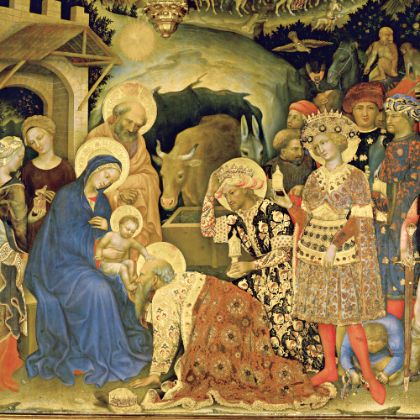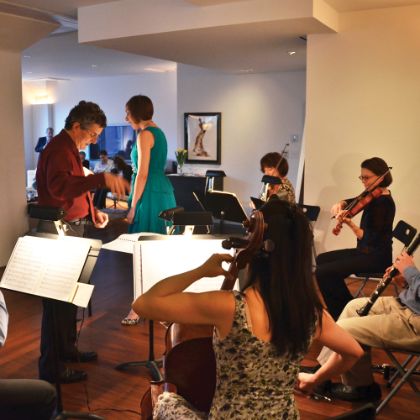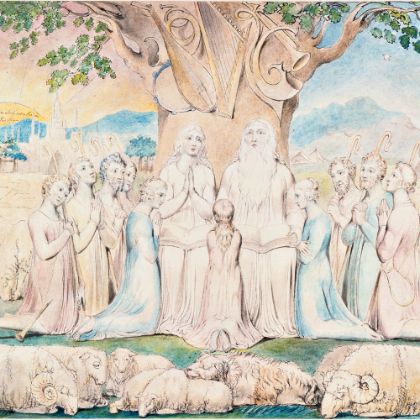Gluck’s Bold Move
The composer’s Don Juan bridged the Baroque and Classical periods in explosive fashion.
By David Hurwitz
If you had to put your finger on the point when the ornate, courtly musical style of the Baroque period yielded to the simpler, more directly expressive approach that we now call “Classical,” a good bet would be 1761. That was the year Christoph Willibald Gluck, a successful but by no means revolutionary forty-seven-year-old composer living in Vienna, created a sensation with his ballet–pantomime Don Juan. Up to that point, Gluck had concentrated on two types of dramatic music: Baroque serious opera (in Italian) and musical comedies with dialogue (in French). Looking back, there were signs of the musical upheaval to come.
For one thing, the most important librettist of the day, Metastasio, hated Gluck’s music. That’s actually a good thing. Metastasio (1698–1782), whose real name was Pietro Antonio Domenico Trapassi, was the official court poet of the Austrian monarchy. His texts were set dozens of times by all of the major and minor composers of the eighteenth century. They celebrated the status quo: the God-ordained rigid class structure of a society based on a hereditary aristocracy at the top and everyone else somewhere below. Gluck used these texts frequently, and often quite successfully. Yet Metastasio regarded Gluck as a musical barbarian — unsubtle, crude and altogether too directly exciting and expressive for his ultra-refined tastes. And Gluck, who liked to change his librettos around to make them more dramatically effective, wasn’t too happy with Metastasio either.
At the same time that this quiet personal conflict was simmering on the back burner of Viennese artistic life, the philosophers of the Enlightenment, Jean-Jacques Rousseau prominent among them, were preaching a return to simplicity, to nature. In the arts, this meant less emphasis on ornamentation and technical display — in music as much as in painting, architecture and literature. Classical proportions and the direct expression of human emotion became paramount considerations. In ballet, this translated as fewer unmotivated dance sequences and a more dynamic process of storytelling through movement and gesture. In other words, pantomime supplanted pure ballet, with even the dance numbers advancing the plot. Fortunately for Gluck, the courtiers in charge of the imperial theaters in Vienna subscribed to this new ethos, as did some important dancer–choreographers. They were looking for a composer willing to join them in making a statement, and in Gluck they found their man.
The story of Don Juan is well-known from Mozart’s opera Don Giovanni. The don is a notrious libertine who, in the process of attempting to seduce Donna Anna, semi-accidentally kills her father. After a further series of misadventures, the statue of the dead man comes to life and interrupts the don’s dinner, demanding that he repent his evil ways. Naturally, the don refuses, the gates of hell open, and a band of demons drags him off to face eternal punishment. It’s a terrifically dramatic story: it has sex, violence and a touch of supernatural horror. Mozart takes about three hours to get through it all. Gluck requires only forty-five minutes. His dance numbers are short, punchy and colorful. There’s a marvelous Spanish-sounding fandango, one of the earliest examples by a non-Spanish composer, and plenty of delectable orchestration.
But what really makes Don Juan the standout piece of its era is the concluding pair of movements, a creepy Larghetto leading to a wild final Chaconne. In these two pieces, Gluck essentially invents what we would today call “horror movie music.” While Baroque composers could, of course, illustrate all kinds of effects, from storms to birdsong to sunrises and earthquakes — think of Vivaldi’s The Four Seasons as a telling, string-only example of compositional cleverness in this regard — all of these effects were extremely stylized, cute and charming rather than viscerally compelling. Gluck, on the other hand, wanted to scare the living daylights out of his audience. His Larghetto is grim and claustrophobic, the loud outbursts that punctuate it startling, his use of dissonance grinding and truly nasty.
The Larghetto leads without pause to the Chaconne, which is technically a series of variations over a repeated bass line, but here paints a vivid portrait of the don’s descent into hell. This is quite possibly the most violent piece of purely orchestral music written up to its time. Swirling violins and loud shrieks from the woodwinds and brass all atop a pitiless bass line leave nothing to the listener’s imagination. You can hear the don’s efforts to escape the demons pursuing him, and imagine them cutting off his path to freedom at each attempt. The music rises to a manic climax on a prolonged dissonant chord followed by a shocking silence, and then descending scales in the strings accompany the don’s demise until, at the very end, order is restored and an uneasy calm prevails.
Gluck’s audience was fascinated by the work, as much for the dancing and decor as for the music itself. It exercised a certain horrid fascination — some listeners actually found the piece ugly, but still couldn’t resist it. When the initial run of performances ended, Gluck salvaged the final Chaconne and inserted it into the 1774 French version of his famous opera Orfeo et Eurydice, the next major work to advance his musical reforms. There the music gained immortality as the “Dance of the Furies” in the opera’s second act.
And the story doesn’t end there. Both as the finale to the ballet and as the “Dance of the Furies,” Gluck’s music inspired a whole new generation of composers. Mozart’s own “hell scene” in Don Giovanni reveals the clear influence of Gluck’s earlier effort, and not just because it’s in the same key. It is the music’s expressive intensity that links the two composers. Gluck was, in fact, a tireless supporter of new music, including Mozart’s, which is interesting given the fact that his chosen successor was none other than Salieri (who, contrary to what we were told in the play and film Amadeus, probably got along with Mozart perfectly well). Italian composer Luigi Boccherini paid Gluck the ultimate compliment by stealing the entire Chaconne and using it as the finale of his Symphony Op. 12, No. 4, subtitled “From the Devil’s House.” The fact that these symphonies were composed for the Spanish court gives you some idea of how far Gluck’s reputation had spread.
The composer who most benefited from Gluck’s example was undoubtedly Haydn, whose “Sturm und Drang” (“Storm and Stress”) period in the early 1770s included some of his most famous symphonies (for example, No. 45, “The Farewell”). Many of these works, full of minor-key anxiety and bite, had the concluding dance of Don Juan firmly in view, until Haydn exorcised this particular demon in the hilarious opening movement of his Symphony No. 80. There, the Don Juan–like opening gets laughed off the stage by some irreverent organ-grinder music.
Gluck’s name, to the extent that listeners today know it at all, has unfortunately become associated with the idea of musical “reform,” a dull, cold, but necessary phase along the way to the supreme achievements of Viennese classicism. In reality, he was anything but pedantic or emotionally inhibited. Listeners looking for an enjoyable and gripping way to discover one of the early masterpieces of the Classical style need look no further than his Don Juan.

Photos: Dana Meilijson, Brian Hatton
-

From Christemasse to Carole
The birth of Christmas in medieval England
Read More
By David Vernier -

The Next (Not-So-)Big Thing
New chamber orchestras are popping up all over America.
Read More
By Colin Eatock -

A Father's Lament
Finding solace in the sound of authentic sorrow
Read More
By Rev. Jake Bohstedt Morrill